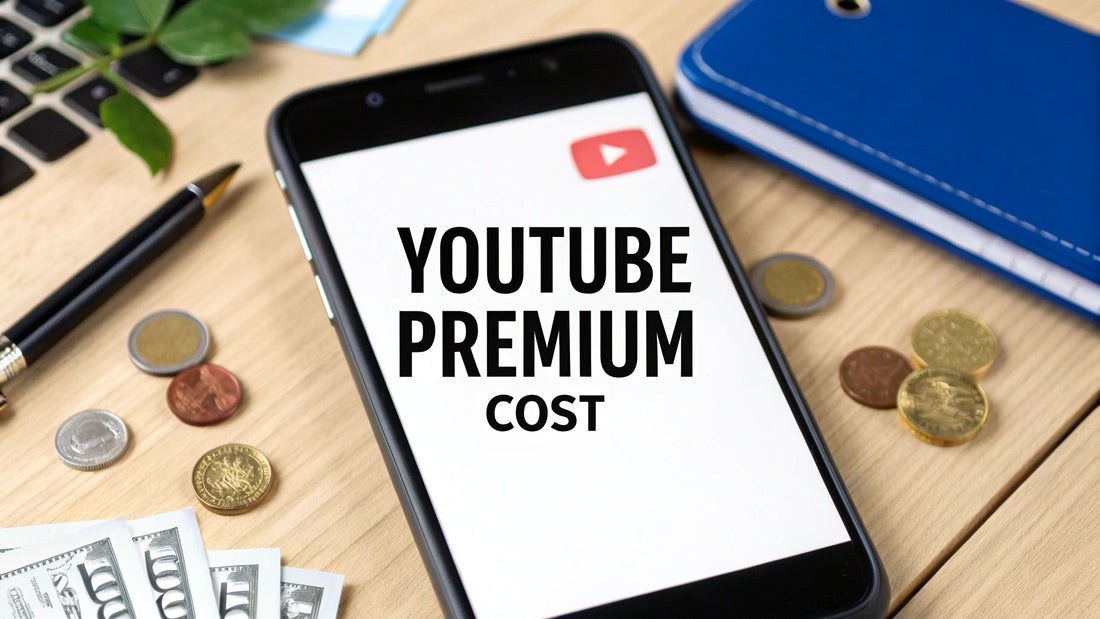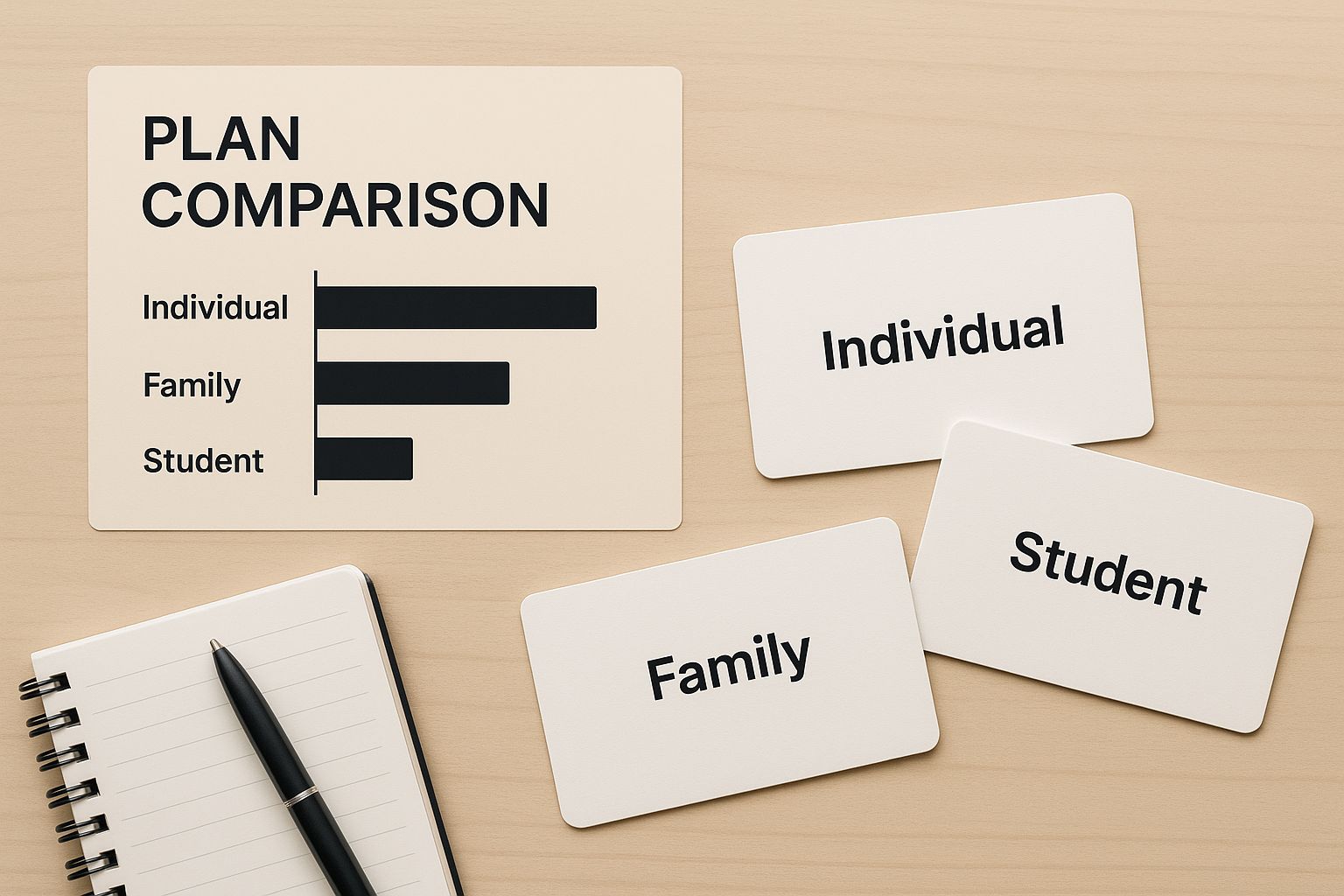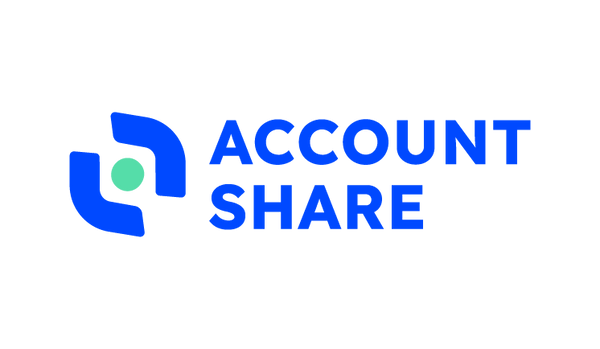
How Much Does YouTube Premium Cost? A Complete Guide
Share
So, you're wondering how much YouTube Premium actually costs. The short and sweet answer is that a standard Individual plan will set you back $13.99 a month here in the United States. That's the price for ditching the ads, downloading videos for offline viewing, and keeping your music playing in the background.
But that $13.99 price tag isn't the whole story. YouTube offers a few different ways to pay, and depending on your situation, you might be able to get a much better deal.
A Snapshot of Current YouTube Premium Costs

To really get a grip on the pricing, you need to look at the three main subscription tiers. Each one is built for a different kind of user. While most people just grab the Individual plan, it's often not the most cost-effective choice.
For families or even a group of housemates, the Family plan can slash the per-person cost. And if you're a student, there's a heavily discounted plan just for you. It's all about making sure you only pay for what you'll actually use.
Comparing the Main Subscription Plans
Let's break down the current pricing structure in the U.S. to see what makes the most sense. Remember, every tier gets you the same core benefits—no ads, offline downloads, background play, and full access to YouTube Music Premium. The only real differences are the price and how many people can use the account.
Here’s a quick look at how the plans stack up.
YouTube Premium Plans and US Pricing
| Plan Type | Monthly Cost (USD) | Number of Users | Best For |
|---|---|---|---|
| Individual | $13.99 | 1 | Solo viewers who watch a lot of content |
| Family | $22.99 | Up to 6 | Families or households looking for the best value |
| Student | $7.99 | 1 | Eligible students on a budget |
This table gives you a clear picture of your options at a glance.
The core plans are pretty straightforward:
- Individual Plan: At $13.99 per month, this is your classic one-person account.
- Family Plan: This is where the value really shines. For $22.99 per month, you can add up to five other people (six total) from the same household.
- Student Plan: If you're an eligible student, you can get all the Premium perks for just $7.99 per month after verifying your status.
If you're always on the hunt for a bargain, it's worth knowing you can often discover YouTube Premium discount deals that can drop these monthly costs even lower.
These prices are the baseline, but keep in mind they're not set in stone. Things like where you live and whether you pay annually can also change the final cost, so it's always good to check the latest rates directly from YouTube.
The Story Behind YouTube's Evolving Prices
The price you pay for YouTube Premium today isn't what it used to be. The service has been on quite a journey, starting out as "YouTube Red" before it was rebranded and the price tag was rejigged more than once. Looking back at this history helps make sense of where the current costs come from.
These aren't just random price hikes. Each change is a reaction to the shifting sands of the digital streaming world. Think about it: content licensing gets more expensive, competition heats up, and general inflation affects everything. All these factors are baked into what you end up paying.
From YouTube Red to Premium Hikes
The real turning point was back in 2018 when YouTube Red officially became YouTube Premium. This was more than a simple name swap; it was a strategic pivot that paved the way for higher prices. The goal was to better match the subscription cost with the growing list of features, especially with YouTube Music being bundled in.
Of course, these price changes didn't roll out uniformly across the globe. Since that 2018 rebrand, YouTube has bumped up its prices several times, and the amounts vary wildly depending on where you live.
For example, the individual plan in the U.S. started at $9.99 under YouTube Red, jumped to $11.99 in 2018, and now sits at $13.99 per month.
But look elsewhere, and the numbers are all over the map. In Argentina, a plan costs just $0.90, while in Switzerland, it's a hefty $21.12. That's a mind-boggling 2,246% difference between the cheapest and most expensive countries.
Many European countries have also felt the pinch, with some family plans shooting up by about 25% and individual plans by around 16.7%. This trend isn't unique to YouTube; it’s happening across the streaming industry as operational costs climb. If you're curious, you can learn more about the global pricing strategy of YouTube Premium and see a detailed breakdown of these trends.
The core takeaway is that YouTube's subscription price is a dynamic figure. It's constantly being adjusted to balance the platform’s growing value—more content, better features—with the economic realities of different markets around the world.
This history of gradual increases shows that the subscription fee is a direct reflection of YouTube's continued investment in creating an ad-free, feature-rich experience. It also explains why your friend in another country might be paying a completely different price for the exact same service.
Cracking the Code on YouTube Premium Plans
Figuring out which YouTube Premium plan is right for you isn't just about chasing the lowest price tag. It's about finding the perfect fit for your lifestyle. Think of it like this: all the plans get rid of ads and unlock extra features, but each one is built for a different kind of user.
YouTube offers three main flavors: the Individual, Family, and Student plans. Getting to know the small differences between them is the secret to getting the most bang for your buck and not paying for stuff you'll never use.
This infographic lays it all out visually, making it easy to compare the plans at a glance.

You can quickly see how the cost and the number of users stack up, which is a great starting point.
Comparing Each Subscription Tier
The Individual plan is exactly what it sounds like—one account, one person. It's the go-to for solo binge-watchers who are tired of interruptions. Simple and effective. But if you're looking for serious savings, this probably isn't where you'll find them.
Now, the Family plan is where the real magic happens for group savings. You pay one monthly price, and you can invite up to five other people to join you, for a grand total of six users. The only catch? Everyone has to live at the same address. YouTube is pretty strict about this and uses things like location data to make sure no one's bending the rules. If you want to dive deeper, you can explore all the details about the YouTube Premium family plan cost and its advantages. When you split that one fee six ways, the per-person cost plummets, making it a no-brainer for any household.
The Family plan essentially turns a personal expense into a shared utility, much like a household Wi-Fi bill, dramatically lowering the individual cost for everyone involved.
Last but not least, there’s the Student plan, a fantastic deal for anyone in higher education. As long as you're enrolled at an eligible college or university, you can get verified through a service called SheerID. You’ll have to re-verify every year, but it's worth it. You get all the perks of the Individual plan for almost half the price—an absolute steal for students on a budget.
Why YouTube Premium Prices Vary Around the World

Ever noticed that a YouTube Premium subscription in Turkey or India costs a fraction of what it does in the United States or Switzerland? You’re not imagining things. This is a deliberate strategy known as regional pricing, and it’s how companies like Google make their services affordable to a global audience.
It all boils down to a core economic idea: purchasing power parity (PPP). In a nutshell, it means that the price of a product should reflect the average income of the local population. A $13.99 monthly fee might seem reasonable in a high-income country, but it could be a major expense in an emerging economy. YouTube gets this.
The Economics Behind the Price Tag
YouTube is playing a long game. By lowering the price in countries with lower average wages, they can bring millions more people into their ecosystem. The goal isn't to get the same revenue from every user, but to maximize the number of users worldwide.
Several factors come into play when setting these local prices:
- Local Competition: If home-grown streaming services are cheap, YouTube has to adjust its pricing to compete.
- Currency Strength: A country's currency value against the US dollar is a huge factor in setting and converting these prices.
- Overall Economy: Things like inflation and national economic growth also get baked into the final subscription cost.
Global YouTube Premium Price Comparison (Individual Plan)
To see just how much prices can vary, let's look at what the individual YouTube Premium plan costs in different countries. We've converted everything to US dollars to make it a fair comparison.
| Country | Monthly Cost (Local Currency) | Approximate Cost (USD) |
|---|---|---|
| United States | $13.99 USD | $13.99 |
| Switzerland | 15.90 CHF | $17.50 |
| United Kingdom | £12.99 GBP | $16.50 |
| Philippines | ₱159 PHP | $2.84 |
| Turkey | 57.99 TRY | $1.70 |
| India | ₹159 INR | $1.90 |
| Argentina | 869 ARS | $0.90 |
As you can see, the difference is massive. A user in Argentina pays less than a dollar, while someone in Switzerland pays over $17 for the exact same service.
India is a perfect case study. The individual plan there is about ₹159, which works out to roughly $1.90 USD. This is a world away from the prices in Western countries. While these prices have been creeping up, as detailed in this Financial Express article on YouTube Premium price shifts, they're still kept incredibly low to match what the local market can bear. We see the same approach in places like Argentina ($0.90), Turkey ($1.70), and the Philippines ($2.84).
By treating each country as its own market, YouTube makes sure it isn't leaving millions of potential subscribers on the table. This approach makes the service accessible to people who would otherwise be priced out, creating a truly global user base.
Is YouTube Premium Actually Worth the Cost?
So, we get to the big question everyone asks when they see the price tag: is it really worth it? The answer isn't a simple yes or no. It's about weighing the monthly cost against what you actually get back in convenience and a better viewing experience.
Ultimately, it comes down to how you use YouTube. Are you on there for hours every day, or do you just pop in for a quick video here and there? The more time you spend on the platform, the more value you're going to squeeze out of a Premium subscription.
Breaking Down the Core Benefits
Think about it this way: you're essentially buying back your time and focus. The most immediate and obvious perk is ad-free viewing. If you're constantly mashing the "skip ad" button, just think about all that time you'd get back. For anyone who watches a lot of content, removing those interruptions alone can make the subscription feel like a bargain.
Then you've got background play, which honestly transforms YouTube. It lets you listen to podcasts, interviews, or music playlists with your phone locked or while you're scrolling through another app. This is a total game-changer if you use YouTube for audio content just as much as video.
On top of that, the subscription also throws in:
- Offline Downloads: This is a lifesaver for flights, subway commutes, or anywhere with spotty Wi-Fi. You can just save videos to your device and watch them whenever, wherever.
- YouTube Music Premium: This is the hidden gem in the whole package. You get a full-blown music streaming service bundled in, which would normally set you back $10.99 per month all by itself.
When you realize YouTube Music Premium is part of the deal, the math starts to look a lot different. If you're already paying for another music streaming service, switching over could make your YouTube Premium subscription practically free.
In the end, figuring out if it's worth it is a personal calculation. Tally up the time you'd save without ads, the sheer convenience of background play and downloads, and the cash value of a premium music service.
If that total value feels greater than the monthly price, it's a no-brainer. If you're still on the fence, it might be helpful to check out a deeper dive into all the YouTube Premium benefits to see everything you'd be getting.
Got Questions About Premium Costs? We've Got Answers
Even with the pricing laid out, there are always those nagging little questions that pop up, especially when you dig into the details. Let's walk through some of the most common ones so you can feel confident before you subscribe. Think of this as clearing up the fine print.
Getting a handle on the rules and requirements is the best way to make sure your membership runs smoothly and you don't get any unexpected surprises.
Do Family Plan Members Really Have to Live Together?
This is a big one. The main rule for the Family plan is that all six members must share the same physical address. YouTube is pretty serious about this and uses things like IP addresses and location data to make sure everyone is actually under the same roof.
On top of that, everyone on the plan needs to be 13 years or older and have a Google account in the same country as the person who set up the plan. If YouTube catches on that members are scattered across different locations, they can suspend the plan, so it's a rule you'll want to stick to.
Can I Save Money With an Annual Plan?
Absolutely, but there's a small catch. If you're going solo, YouTube offers an annual subscription for the Individual plan in many countries. Paying for a year upfront usually works out to getting about two months free compared to the monthly rate, which is a solid saving.
It's a fantastic deal if you know you'll be using it long-term. Just keep in mind that this annual discount is only for the Individual plan—it’s not an option for Family or Student plans.
Planning ahead with an annual subscription can seriously lower the overall cost of YouTube Premium, making it a much more budget-friendly choice over the long haul.
How Does the Student Discount Actually Work?
So, how do you prove you're a student? First, you have to be enrolled at an eligible college or university. YouTube uses a service called SheerID to handle the verification. When you sign up, you'll be asked for proof, like a student ID, transcript, or other official school document.
And it's not a one-and-done thing. You'll need to re-verify that you're still a student once every year to keep your discount. You can do this for a maximum of four years.
Are There Any Hidden Fees or Taxes?
What you see is mostly what you get. The price you see advertised is the base cost, but your final bill might be a little higher. Depending on where you live, local taxes (like VAT or sales tax) will be added on top.
Your monthly statement from Google will show a clear breakdown of the subscription cost plus any required taxes, so there’s no mystery—just something to be aware of.
Ready to slash your subscription costs without compromising on features? AccountShare makes it easy to join group purchases for services like YouTube Premium, ensuring you get the best price securely and efficiently. Start saving today at AccountShare!
